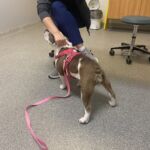11/2/21 – Please welcome Harley! Harley was turned over to us by her breeder after a visit to with cardiologist. She was born with a heart murmur and further testing at 11 weeks old showed she has severe pulmonic stenosis (PS) and mild subaortic stenosis (SAS). She started taking a beta blocker, atenolol, to try and reduce the degree of obstruction and attempts to reduce the workload of her heart. Unfortunately, she has been showing clinical signs of fatigue, fainting and collapsing. She is on strict crate rest with no activity. Just seeing people or dogs causes her to collapse. She will see the cardiologist again in one month for a second EKC.
11/16/21 – Harley saw the cardiologist today for further testing and unfortunately she has more issues with her heart than we originally thought. Four issues to be exact! She has diagnosed with Tetralogy of Fallot. Tetralogy of Fallot is a congenital abnormality consisting of an overriding aorta, a ventricular septal defect, pulmonic stenosis, and right ventricular concentric hypertrophy (thickening) in response to the pulmonic stenosis. The ventricular septal defect, in particular, creates a right to left shunting of blood which leads to increased number of red blood cells (polycythemia) due to decreased amount of oxygen being carried by the blood. An increase in red blood cells is not ideal as this can cause the blood to move slower in the body resulting in weakness, collapse or blood clots that could result in death. The overriding aorta can allow mixture of deoxygenated with oxygenated blood which can result in decreased amount of oxygenated blood being pushed through the body. Finally, pulmonic stenosis, which is a narrowing of the pulmonic valves, creates an increase in pressure in the right ventricle due to not all of the blood being able to pass through the narrowed valve. This increase in pressure causes the right ventricle to thicken in response. This can potentially lead to right sided heart failure due to the right ventricle losing the ability to adequately pump blood forward, thus causing blood to back up into the abdomen.
Today on echocardiogram, Harley had all four of the four criteria seen for Tetralogy of Fallot. In some dogs with pulmonic stenosis, a procedure called a balloon valvuloplasty can be preformed to correct the pulmonic stenosis and help to decrease the amount of right ventricular hypertrophy that is occurring. Unfortunately, Harley’s pulmonic valve is not conducive to this kind of surgery as his annulus (a ring shaped structure that around the valve) is hypoplastic and will not easily give way. There is also the risk of a vascular abnormality that is not uncommonly seen in the bulldog, this is known as an R2A anomaly. We discussed that this vascular abnormality can result in a coronary artery being routed around the pulmonic valve. This means that during
the balloon procedure there is a risk of occluding (clamping) the vessel which can lead to decreased blood flow to the heart muscle (myocardial infarction). Based on the complexity of Harley’s cardiac abnormalities we have determined that a balloon valvuloplasty is not the best surgical approach to improve her quality of life.
Alternatively, as discussed two other surgical options for Harley and these are a modified Blalock-Taussig (MBT) graft procedure or a definitive repair using open heart surgery with cardiac bypass. The MBT graft procedure essentially creates an bypass vessel from the aorta to the pulmonary artery. The goal of this procedure is to increase blood flow to the lungs which in turn increases oxygen saturation of the blood and reduces clinical signs associated with hypoxemia (decreased oxygen in the blood) like syncope (fainting), cyanosis (blue tinged mucous membranes), exercise intolerance and fatigue. While this procedure is certainly
an option it is not a definitive repair of Harley’s underlying cardiac abnormalities. The approximate cost of this procedure is $4000-$6000.
We are switching her medication to Propanolol. This works on the muscle of the heart to slow the rhythm of the heart which will decrease the workload of the heart as well as the added benefit of working on the bodies vascular system to constrict blood vessels which will ultimately
lead to increase an increased pressure in the left side of the heart. The goal is to reduce the right to left shunting of blood created by the ventricular septal defect and ultimately reduce Harley’s syncopal episodes. We will see how she response on this medication over the next three months. At that time, we will repeat the echocardiogram and decide if Blalock-Taussing graft procedure is the best option for her.
11/22/21 – After further discussion with the team at UGA we have decided to move forward with surgery as soon as possible. Harley’s heart issues are extras and she struggles to do normal everyday activities. This surgery gives her the best chance at living a normal life. This is a big surgery with a big bill of $4,000-$6,000 dollars. Please help us help Harley and donate if you can. We appreciate your support and we know Harley does too.
1/6/22 – Harley had her heart surgery today. This was a complicated surgery and she was under for anesthesia for five hours. The surgical team had a challenging time getting the graft into place but it is in and doing it’s job. The next 72 hours are critical while we wait and see if her body accepts or rejects the graft.
7/14/22 – Harley was presented to the UGA Cardiology Service today for recheck evaluation of Tetralogy of Fallot after placement of a modified Blalock-Taussig-Thomas shunt (mBTT). The shunt remains patent (open), with continuous blood flowing from the subclavian artery to the pulmonary artery via the previously placed graft. In addition, the structural changes to her heart are static, and have not worsened significantly since her last echocardiogram.
We also rechecked Harley’s red blood cell count (packed cell volume or PCV) today. The ventricular septal defect (VSD) in her heart allows deoxygenated blood to flow from the right side of the heart to the left side, which then gets sent out into the systemic circulation. The body responds to the lower amount of oxygen by producing more red blood cells in hopes of carrying more oxygen. Harley’s PCV was slightly higher than what we normally see in dogs; however, not high enough that would cause her any problems or require treatment. We will continue to monitor her PCV at further rechecks. If there are too many red blood cells, it can make it hard for fluid to move through the body leading to symptoms such as behavior changes, seizures, ataxia, or lethargy. We are watching her closely for these clinical signs. We were able to discontinue her clopidogrel (Plavix); but we will continue her on her current dose of propranolol and she will need this for life. We were advised to let Harley to set her own pace regarding her activity. She will need to see the cardiologist again in six months and likely every six months for the remainder of her life. We would like to recheck an echocardiogram in another 4 to 6 months. She has been cleared to have surgery; we will spay her and address her cherry eyes in a few weeks. She will be available for adoption once she recovers from surgery. She will only be placed in a low key, dog free, kids free home so that she can live a quite, low key lifestyle.
October 31, 2022 – Harley crossed over the Rainbow Bridge today. We tried everything to fix her heart but unfortunately we were not able to.
Please keep her foster family in your thoughts.
Rest In Peace Harley






















